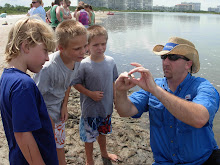In a recent post, I discussed the interim regulations for gag grouper in federal Gulf waters. I've also shared information on goliath grouper management in the past. Both of these species are found in Southwest Florida waters, and if you are a fisherman, you know that they have both caused their share of controversy in recent years. The Gulf of Mexico Fishery Management Council, who is one of eight regional fishery management councils established by the Magnuson-Stevens Fishery Conservation Management Act, and is responsible for managing fisheries in the exclusive economic zone of the Gulf of Mexico recently held its February Council meeting Feb 7-10 in Gulfport, Mississippi. I wanted to share some of the hightlights relating to gag and goliath grouper that came out of the meeting.
Gag Grouper
 The Council asked staff to prepare an interim rule for consideration during the April Council meeting that sets the 2011 recreational season for gag from September 16 through November 15. This request was made after the Council reviewed the results of a re-run of the 2009 gag update assessment. The re-run adjusted the size distribution of undersized released fish in the recreational fishery and used newly available observer
The Council asked staff to prepare an interim rule for consideration during the April Council meeting that sets the 2011 recreational season for gag from September 16 through November 15. This request was made after the Council reviewed the results of a re-run of the 2009 gag update assessment. The re-run adjusted the size distribution of undersized released fish in the recreational fishery and used newly available observerFor the commercial sector, a major unknown factor is the levels of dead discards due to the small amount of gag individual fishing quota (IFQ) available, and whether commercial fishermen can successfully avoid catching gag while fishing for red grouper. Because the grouper IFQ system has only been in place for one year, the commercial sector has not established a track record to demonstrate how successfully fishermen can avoid catching fish for which they do not have IFQ shares. As a result, the Council set the 2011 commercial quota at a precautionary level of 430,000 pounds. This includes the 100,000 pounds previously released via interim rule at the beginning of the year.
The Council also continued work on Draft Reef Fish Amendment 32 to establish a rebuilding plan for gag, which has been declared by NOAA Fisheries to be overfished and undergoing overfishing. Amendment 32 will be implemented in 2012 and should allow for an increase in the 2012 total allowable catch of gag, provided that the 2011 catches from recreational and commercial fishing do not exceed the levels needed to
rebuild. To help assure that the rebuilding plan stays on track, the Council directed staff to include alternatives for recreational quota closure authority for the NOAA Fisheries Regional Administrator, and overage adjustments if a sector exceeds its allocation. This is similar to the quota closure authority and overage adjustments of the greater amberjack fishery, which is also under a rebuilding plan. The Council also streamlined the amendment by removing several alternatives that were intended to address bycatch, and by moving a section on data collection and monitoring programs out of Amendment 32 and into a more appropriate amendment. In addition, alternatives to increase the recreational bag limit of red grouper will be added to the amendment. Public hearings on Amendment 32 will be scheduled around the Gulf coast this spring or summer.
Goliath Grouper
The Council received a summary of a new stock assessment on goliath grouper. The assessment showed that the goliath grouper stock has clearly improved since the moratorium was implemented in 1990. However, questions still remain about the stock. For example, there is a lack of information about the basic biology of the goliath grouper, such as how long they can live. Estimates range anywhere from 37 years to 80 years.
Another unknown is whether goliath grouper change sex like gag and some other grouper species. Also, the assessment, which was conducted by the Florida Fish and Wildlife Research Institute, focused on the south Florida portion of the stock. While that area is the center of abundance, goliath grouper are found throughout the Gulf of Mexico and in the Caribbean, and information about the status of the stock in areas not covered by the assessment is lacking. Because of the biological uncertainties and the limited geographic scope of the assessment, the Council’s Scientific and Statistical Committee was unable to set a level of acceptable biological catch. Instead, they recommended that the moratorium be continued through 2015, and that during this period, a coordinated scientific sampling plan be produced to address the data needs. The Florida Wildlife Conservation Commission will review the assessment during its February meeting and may consider some sort of limited harvest of Goliath in state waters.
To view the entire Gulf Council Update visit:
http://www.gulfcouncil.org/news_resources/Press%20Releases/FebruaryUpdate.pdf






No comments:
Post a Comment